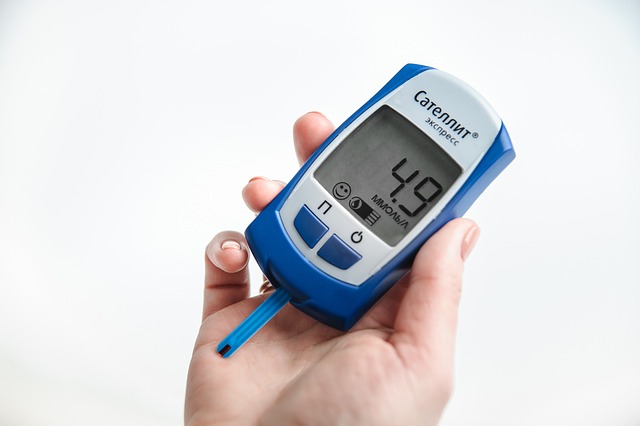Learning the first signs of diabetes in men can help prevent type 2 diabetes
Diabetes is among the most common chronic conditions in the U.S. The Centers for Disease Control and Prevention, or CDC, reports that in 2015, about 1 in 11, or 30.3 million, adults had diabetes, and that included 12 million, or 1 in 4, adults 65 or older. Another 84.1 million, or 1 in 3 adults, had prediabetes, including nearly half of older adults.
Why are diabetes signs in men so important? Consider these facts.
- Men are more likely to have prediabetes (also known as borderline diabetes), but less likely to be aware of it.
- Men are more likely to have diabetes, but less likely to be diagnosed with it.
- Most men with prediabetes will get diabetes within 5 to 10 years if they do not take steps to prevent it.
- Men with diabetes are likely to develop complications if they do not manage it well.
The good news is that you can lower your risk for diabetes if you have prediabetes, and lower your risk for diabetes complications if you have it.
Many of the signs and symptoms of diabetes are the same in men and women, but there are some signs that are only in men. Being familiar with both the signs common to both men and women, as well as additional diabetes symptoms that are specific to men, can help you recognize if you may have diabetes or prediabetes.
If you have diabetes signs, you can get medical help to see whether you have diabetes, and if so, to get help managing your diabetes and preventing complications. The earlier you get help, the better you can manage your condition to stay healthy. Taking charge early means you can work on practicing self-management strategies, such as eating right, testing your blood sugar, and getting active. Early action also gives you the chance to test tools, such as Lark Diabetes Health Coach, that can help you make these healthy behaviors into lifelong habits.
What Is Diabetes, and Why Does It Happen?
In the normal case, your blood glucose levels rise after a meal as your body processes the carbohydrates and other nutrients in it. The increase in your blood sugar levels triggers your pancreas to release a hormone called insulin into your bloodstream. Insulin helps lower your blood sugar levels back down by allowing the extra glucose to get into the cells of your body that need it for energy, and storing the rest as fat. "Diabetes mellitus" literally means, "sugar urine disease." It is a condition in which your blood sugar is abnormally high – so high that excess sugar is excreted in your urine. The result is that the cells of your body are unable to transport glucose out of your bloodstream, and so your blood glucose, or blood sugar, levels remain too high, far above normal blood sugar levels. (If you want to skip this background on how Diabetes develops, scroll down to "Diabetes Signs Unique to Men")
How Does Diabetes Happen?
Diabetes is a condition that happens when your blood sugar, or blood glucose, levels are too high. It can happen when:
- Your pancreas do not produce insulin (type 1 diabetes).
- The cells of your body are resistant to the effects of insulin (insulin resistance - type 2 diabetes).
- Your body does not produce enough insulin to keep up with your body's demand (type 2 diabetes).
Types of Diabetes in Men
The types of diabetes in men are type 1 and type 2 diabetes. In type 1 diabetes, your pancreas can no longer produce insulin. In type 2 diabetes, which includes 90-95% of cases, your body's cells are more resistant to insulin's effects.
Type 1 Diabetes
Type 1 diabetes is an autoimmune disease in which your immune system attacks and destroys beta cells, which are the cells in your pancreas that produce insulin. The causes of type 1 diabetes are unknown. There is probably a genetic factor, and usually there is an environmental trigger, such as a viral infection. Type 1 diabetes most commonly appears during childhood or adolescence.
Type 2 Diabetes
Type 2 diabetes is linked to insulin resistance in the cells of your body. Excessive amounts of blood glucose create an increasingly higher demand for insulin. Eventually, the pancreas cannot make enough insulin to keep up with demand, and blood sugar levels rise.
Here is how a classic case of type 2 diabetes develops. A man repeatedly places higher demands on his insulin response by having unusually high blood sugar, often due to eating too much, consuming alcohol when prediabetic, or exercising too little. He produces increasing amounts of insulin to handle his high levels of blood glucose. His body's cells grow tolerant, and then resistant (remember insulin resistance?), to insulin's effects, so the beta cells in the pancreas work harder to produce more insulin to keep up with demand. This begins insulin sensitivity and insulin resistance symptoms in males.
Eventually, two things happen to lead to
higher blood sugar levels. [3]
- Insulin resistance becomes strong enough that blood glucose levels stay high. This is when prediabetes and then diabetes can be diagnosed.
- The pancreatic beta cells become exhausted and produce much less insulin. This happens in the later stages of diabetes.
Prediabetes
Prediabetes is a condition that develops before type 2 diabetes. With prediabetes, your blood sugar is higher than normal, but lower than in diabetes. Prediabetes does not always lead to signs, but it can. Signs on the skin of prediabetes in men could include acanthosis nigricans, which is darkening of the skin on the neck or armpits, or changes in their eyes as an early sign of retinopathy.
Who Is More Likely to Get Diabetes?
Risk factors for type 2 diabetes include both nonmodifiable and modifiable factors. You are at higher risk for pre diabetes and diabetes if any of the following apply to you.
- Age over 45
- Family history of diabetes
- Overweight or obese
- Physical inactivity
- Smoking
- High total or LDL, or low HDL, cholesterol, or high triglycerides or blood pressure
- Certain minorities, such as Asian American, Pacific Islander, American Indian, Hispanic/Latino, Native Hawaiian, or African American.
You can lower your risk of type 2 diabetes by losing extra pounds (particularly belly fat), eating a nutritious diet, getting regular exercise, and managing health conditions such as high cholesterol or blood pressure. If you have prediabetes, you can sign up for a Centers for Disease Control and Prevention (CDC)-recognized Diabetes Prevention Program (DPP), which can lower risk for diabetes by over 50%. Lark offers an entirely-digital program that is convenient and easy to follow.
Common Symptoms of Diabetes in Men and Women
While diabetes early signs in men may be absent or subtle, signs of type 2 diabetes can occur. They can be a reflection of too much sugar in the blood, and diabetes signs in men over 40 can include:
- Increased and excessive thirst and more frequent urination.
- Unexplained or unintentional weight loss, fatigue (and feeling sleepy after eating), and extra hunger (which can happen when your body does not properly use blood glucose), which comes from the foods you eat, since sugar is not being processed properly
- Impaired wound healing, skin infections, and numbness, due to damage to your blood vessels and poorer circulation.
Type 2 diabetes is no longer a disease that only old folks get. It is becoming more common among younger people. Signs of diabetes in men over 40 are the same signs that might be familiar to you if you have seen your parents or grandparents manage diabetes.
Type 1 diabetes signs in men are more pronounced, and tend to happen in adolescence, but are the same as those listed above. They come on more suddenly, over the course of days or weeks. In contrast, type 2 diabetes can take years to develop.
Even though diabetes signs in men over 50 may be subtle, or they may seem like more of a nuisance than a medical emergency, they should not be ignored. They could indicate the presence of diabetes or prediabetes, since men are at particular risk. Getting your diabetes or prediabetes diagnosed means you can manage or treat it. With prediabetes, that means you can act to lower your risk for developing diabetes, and if you already have diabetes, managing it properly means you can prevent or delay complications such as blindness, kidney disease, and cardiovascular disease.
How Is Diabetes Different in Men Compared to Women?
The way type 2 diabetes develops in men versus women is the same, with insulin resistance gradually developing and blood sugar levels eventually rising. However, men have higher rates of diabetes, according to the CDC. In 2015, 12.7% of American men, compared to 11.7% of women, had type 2 diabetes.
This may be partly related to men being biologically more susceptible than women. One study, published in "Diabetologia," looked at the relationship between body weight and diabetes diagnosis among 51,920 men and 43,137 women. Results showed that men tend to be diagnosed with diabetes at a lower body mass index (BMI) than women. The research results suggest that while extra body weight is a risk factor for both genders, it is more dangerous for men.
Why does extra body fat appear to be more dangerous for men than women? It is probably related to where the fat is stored in the body. Women tend to have a "pear-shaped" body, with more fat accumulating around the hips and thighs. In contrast, men tend to have "apple-shaped" bodies, with more fat accumulating around organs in the mid-section. More importantly, this abdominal fat has negative metabolic effects.

Diabetes Signs Unique to Men
Many of the symptoms of diabetes are the same in men and women, but the National Institututes of Health (NIH) National Institute of Diabetes and Digestive and Kidney Diseases (NIDDK) explains that some signs and complications of diabetes are present in men only. As with complications such as vision problems, kidney disease, and neuropathy, diabetes-related bladder and sexual problems in men can result from slow wound healing.
Diabetes signs in men can include:
- Erectile dysfunction (ED), which means you cannot achieve or hold an erection for long enough to have acceptable intercourse. The NIDDK says that half of men with diabetes get ED, and are three times more likely than men without diabetes to get ED.
- Low testosterone, or "low T," can happen as you age, and is more likely when you are overweight and/or have type 2 diabetes. Testosterone is a sex hormone, and low levels can lead to depression, lack of energy, or reduced sex drive. Testosterone therapy with a patch, gel, or injection, can help, but it has side effects.
- Retrograde ejaculation, which happens if semen goes into your bladder instead of your penis. This is not dangerous to you, but it can cause fertility problems that make conception more difficult. If you are trying to have a baby, you might be advised to change your diabetes care plan or to try intrauterine insemination (IUI) with a fertility specialist.
- Other concerns, such as genital itching and Peyronie's disease (penile curvature), which can result from poor blood flow due to neuropathy.
Although discussing diabetes signs in men sexually can seem embarrassing, it is important to bring up any concerns with your doctor. Healthcare providers are trained to talk about these issues, and they can help you keep your sexual life as healthy and fulfilling as possible.
It is also important to recognize that these and other diabetes signs and complications are the result of poorly controlled blood sugar. You can prevent or delay these and other diabetes complications by taking diabetes management steps.
Diabetes Studies and Research among Men
Type 2 diabetes is far more common in men than type 1 diabetes, with type 2 diabetes accounting for about 19 out of 20 cases of diabetes. Diabetes is the seventh-leading cause of death in the United States, but that figure is misleading, since diabetes is a major risk factor for:
- Heart disease (top cause of death)
- Stroke (fifth-leading cause of death)
- Kidney disease (ninth-leading cause of death).
Proper management of diabetes and prediabetes can reduce the risk of early death from diabetes. Men who are diagnosed with prediabetes or diabetes should follow a care program, but many men are unaware that they have high blood sugar. About 89.4% of men with prediabetes do not know that they have it, and almost 25% of men with diabetes are unaware of it.
Care and Treatment of Diabetes in Men
While men can have serious consequences from diabetes, the great news is that if you have prediabetes you can delay or prevent type 2 diabetes with a healthier lifestyle. If you have diabetes, you can delay or prevent complications. Your treatment plan should include self-management behaviors and medical care.
Medical Care
Your diabetes treatment team is responsible for keeping you healthy, and periodically assessing and evaluating your treatment plan. You are at the center of your treatment team, but there are many medical experts who can help you stay healthy. The American Diabetes Association lists them.
- Primary diabetes doctor: an internist or endocrinologist who is experienced in helping patients with diabetes and who makes you feel comfortable.
- Nurse educator: a nurse with diabetes training who can teach you day-to-day strategies such as how to manage your medications and blood glucose measurements.
- Dietitian: a professional in nutrition to help you lose weight, if needed, and monitor carbohydrates and other nutrients.
- Eye doctor: an opthamologist or optometrist who is trained to monitor changes in your eyes due to diabetes complications such as retinopathy.
- Podiatrist: a foot doctor can check your feet for infections and other signs of trouble, since diabetic neuropathy means that even minor wounds and calluses can lead to major problems. Burning toes can be a sign of diabetes in men.
- Dentist: to check for gum disease, which is common in diabetes.
- Pharmacist: medications can be a large part of your type 2 diabetes care plan, and they can get complicated.
Self-Management
Diabetes self-management is where the center of your healthcare team – you – gets to shine. Self-management includes the daily actions that you take to stay healthy. Your jobs include:
- Taking your medications as prescribed.
- Losing weight if you have extra pounds, since losing even a few pounds leads to reductions in blood sugar, cholesterol levels, and blood pressure.
- Eating nutritious foods, such as vegetables, fruits, healthy fats, legumes, and lean proteins.
- Limiting unhealthy foods, such as red meat, sugar-sweetened beverages, and foods with added sugars.
- Controlling carbohydrate portions to help keep blood sugar levels from fluctuating too much.
- Exercising regularly, with a goal of eventually achieving at least 150 minutes per week of moderate aerobic exercise, plus strength training 2 to 3 times weekly.
- Measuring your blood glucose 2 or more times a day, as your doctor recommends.
- Scheduling and attending all recommended medical and dental appointments.
Self-management support is among the core elements of chronic disease management. Your dietitian, nurse, and experts can work with you on strategies that work for you, but while your healthcare team is there for regular appointments and at other times, they are not available 24/7.
A digital nurse, such as Lark, can help with diabetes management in men. Your Lark nurse is at your fingertips all day, every day, to provide that extra encouragement to get active, remind you to take your meds, or cheer when your blood sugar levels have been in check recently. The Diabetes Management Program steps in with recommendations for when your blood sugar gets to low, and tells you which appointments are suggested for people with diabetes.
Understand Your Treatment Options
You can support optimal health when you understand your treatment options, which allows you to be proactive and in control. Ideally, select a doctor and other care team members who are knowledgeable and available to answer your questions. As you monitor your blood sugar levels, you can feel empowered by seeing the control you have over them, and confident that you can continue to take the necessary steps to stay healthy.
Also ask your healthcare team what additional support is available. You may be entitled to reimbursement for participating in instructional programs with initial and ongoing support, for example. You might also be eligible to use programs such as Lark, which is a health coach available 24/7 on your smartphone. Check for the signs of being at risk for diabetes, and take action - it's in your hands.
What is FAQ?
Lorem ipsum dolor sit amet, consectetur adipiscing elit, sed do eiusmod tempor incididunt ut labore et dolore magna aliqua. Ut enim ad minim veniam, quis nostrud exercitation ullamco laboris nisi ut aliquip ex ea commodo consequat.
What is FAQ?
Lorem ipsum dolor sit amet, consectetur adipiscing elit, sed do eiusmod tempor incididunt ut labore et dolore magna aliqua. Ut enim ad minim veniam, quis nostrud exercitation ullamco laboris nisi ut aliquip ex ea commodo consequat.












.webp)







